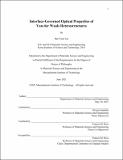Interface-Governed Optical Properties of Van der Waals Heterostructures
Author(s)
Lee, Hae Yeon
DownloadThesis PDF (8.674Mb)
Advisor
Gradečak, Silvija
Ross, Frances M.
Terms of use
Metadata
Show full item recordAbstract
Van der Waals (vdW) layered materials are an emerging class of materials that can be readily separated into atomically thin layers, exhibiting distinct physical properties compared to their bulk counterparts. Moreover, each of the layers can be vertically assembled into vdW heterostructures, opening a new way to design materials with novel electronic and optical properties. To design vdW heterostructures with desirable functionalities, proper interfacial engineering is essential as vdW interfaces between the layers govern the physical properties of the entire structure. In this thesis, I investigate the optical properties of vdW heterostructures in which the interfaces are engineered by hetero-interfacial coupling, atomic misalignment, and mechanical deformation.
Firstly, cathodoluminescence (CL) from monolayer transition metal dichalcogenides (TMDs) was demonstrated in scanning transmission electron microscope (STEM) for the first time by utilizing the interfacial coupling with hexagonal boron nitride (hBN). The effect of imperfect interfaces on CL is directly visualized by nanoscale optical-structural correlation, showing that STEM-CL is an efficient tool to characterize optical emission of monolayers TMDs at nanoscale. Next, it was shown that the optical properties of hBN multilayers can be continuously tuned by the twist angle at the inner interface. Due to the formation of moiré superlattice at the twisted interface, a new moiré band gap is formed, of which magnitude decreases continuously with increasing twist angle, resulting in tunable luminescence wavelength and intensity. This work extends the moiré superlattice-related phenomena beyond monolayer-based system and suggests a strategy to control light in the ultraviolet region. Lastly, the effect of mechanical bending on the optical properties of multilayers is studied by employing bubbles buried inside the vdW multilayers. The materials confined in the bubbles are used to modify bubble geometry and its optical properties under an electron beam. As a result, strong and localized luminescence is observed from the bubbles that forms optical cavities where the geometry can be engineered by the theoretical model developed here.
This thesis provides three new approaches to modulate the optical emission in vdW heterostructures by interfacial engineering, which provides insight into the role of interfaces as well as motivates further work on designing vdW heterostructures for optoelectronic applications.
Date issued
2021-06Department
Massachusetts Institute of Technology. Department of Materials Science and EngineeringPublisher
Massachusetts Institute of Technology